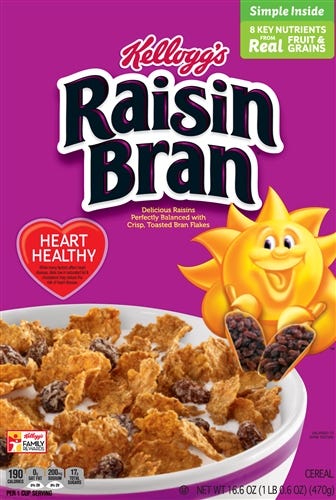Americans have been eating way more cereal in the pandemic. Here’s why that’s a problem
There’s almost as much sugar in a cup of Raisin Bran than a Snicker’s bar. It’s time to change our breakfast habits
Kristen Berman
PSA: Want to dive into the sugar stats in this article? go here
No one would give a cigarette to a child. Why? Because smoking kills. But we should also cringe at consuming something else that’s equally as common as smoking used to be: sugary cereal.
While it might not seem like a bowl of Raisin Bran is as dangerous as tobacco, obesity is associated with nearly 1 in 5 deaths yearly in the U.S., according to the American Journal of Public Health. The WHO reports that at least 2.8M people die yearly from overweight or obesity.
Of course, we can’t solely blame cereal makers for these statistics, but they’re certainly not innocent. When you look at our natural serving sizes (about 2 cups), there’s more sugar in a bowl of Raisin Bran than in a Snickers bar (yes, really).

This is especially important to bring to light now, given that cereal consumption is way up. “With so many people now working from home … many consumers are no longer eating on-the-go or foodservice breakfasts,” said consumer analyst Ryan Whittaker. “Instead … [a]nxieties caused by uncertainty around the pandemic have produced a tendency to fall back on familiar branded products, especially ones that remind the consumer of their childhood.”
And childhood, for many, included favorites like Frosted Flakes, Apple Jacks, Cap’n Crunch, Special K, Lucky Charms, and Honey Nut Cheerios. So we have people eating more cereal than in years, at the same time as an obesity epidemic. This is not a good combination, especially since who eats a lot of that cereal?
Kids.
So what do we do?
There are two things we consumers should do, and two things cereal companies should do.
The primary thing we need to do as individuals is to change our mental accounting of what cereal is. Basically, this means we move it from the category of “healthy breakfast option” or even just “breakfast option” firmly into the category of “dessert.”
Beyond Meat has attempted to change the mental model of their plant-based meals by taking advantage of mental accounting — they moved their veggie burgers to the meat aisle and sales went up. Context matters.
Cereal is a treat. It’s special. It’s like eating a KitKat bar. This isn’t an exaggeration — the average amount of sugar per serving in cereal is 12 grams. But no one eats only a serving; when researchers tested how much people actually put into a 12-ounce bowl, they poured a whopping 24–92% more than the “serving size.”
Or, in the words of the Environmental Working Group in their report on breakfast cereals and the nation’s childhood obesity epidemic, “the labels are misleading: the sugar content is based on an outdated and unrealistic serving size that is one-fourth to one-half smaller than the average American child or teenager actually eats.”
When you calculate the amount people actually eat (a little less than 2 cups), Kellogg and General Mills’ new cereals cram in an average of 23 grams of sugar. One cup of Honey Nut Cheerios has more sugar than three Chips Ahoy! cookies.

In addition to treating cereal like dessert (not a meal), we should use smaller bowls to eat it. Yep, this really works — research shows that the smaller the bowl, the less you’ll over-pour.
Steps cereal companies should take
Last year Kellogg finally stopped (because of a lawsuit) calling their cereals healthy. But they still call their company a well-being company.
If they’re truly going to be about well-being, rather than continuing to come up with even more sugary options (like Pumpkin Spice Frosted Mini-Wheats), companies like Kellogg and General Mills should invest in inventing healthier breakfast cereals. Sadly, this is not the trend they’re on. The average amount of sugar per cup is currently going up, not down: there’s 14% more sugar in newly released cereals as compared to the classics. The all-time winner was released in 2019: Fillows. It packs 25 grams of sugar into each cup and is described as a “Pillsbury Cinnamon Roll.” The fact is, 25 grams is literally all the sugar you’re supposed to eat in one day.

If healthier innovation isn’t in the cards for these companies, then they should just re-wind the clock. Regular Cheerios (not the newer, sugar-coated varieties) clocks in at the lowest per cup: 1.3 grams. Certainly, some progress is being made — both Cheerios and Honey Nut Cheerios (the most popular cereal in the U.S.) are both now gluten-free. The same is true for Lucky Charms and Chex. But these gluten-free cereals are still sugar-full. We know selling calling something “health food” is a losing strategy, but how about putting all those marketing dollars into designing healthy foods that taste better and parents can actually get behind?
So what should you eat for breakfast?
When you move cereal into the category of dessert, you’re now bereft of an easy and familiar breakfast option. A great alternative is oatmeal. It’s full of wholesome fiber, low-glycemic (gives you steady energy throughout the day instead of a quick spike), and is a cozy option in cold winter months.
Plus, if you do it right it can be quick and easy: Just make a big batch of steel-cut oatmeal (healthier than instant) at the beginning of the week, and grab healthy toppings like almond butter, berries, walnuts, and coconut flakes. You could even add a tablespoon of brown sugar — that’s still less than half of what’s in a “natural” portion of Honey Nut Cheerios.
For bonus points, hard-boil a half-dozen eggs at the beginning of the week and have one of those in the morning to boost your protein level.
Just make sure to tell your cereal it’s being moved to the dessert aisle.
